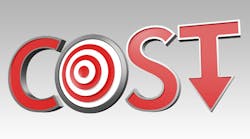U.S. manufacturing executives have an opportunity to make their factories even more competitive through parts and components de-costing programs. De-costing is simply a term that refers to removing cost from operations period-over-period. Parts and components usage is a great place to focus because improvements can provide such clear returns.
On paper, de-costing savings show in reduced spending on parts and components. These typically stem from a strategic choice to invest in high-quality parts and world-class maintenance practices. For example, a manufacturing company might purchase a premium bearing that costs 30% more than a bargain-priced bearing. But if the premium bearing lasts twice as long, the plant saves 50% of its bearing procurement cost alone. When the use of superior parts is combined with implementation of trial-tested maintenance standards, results expand to include reduced machinery downtime, improved productivity and stronger output.
Strategic partnerships with suppliers are essential to the start-up and success of de-costing initiatives. Factories with a strong track record in de-costing establish local customer teams made up of top suppliers. Participants might include original equipment manufacturers, parts and components manufacturers, equipment rebuilders, and distributors. These suppliers work with the factory’s procurement, operations and maintenance staff to meet de-costing metrics established by the business.
Executive sponsorship from the plant’s leadership can be a make-or-break factor in a de-costing program’s success or failure. For example, a leader might need to guide the team through short-term disruptions in procurement cost goals during the quest to bigger savings down the road.
It can be challenging to track cost reductions across parts and components procurement and machinery maintenance. Most manufacturers don’t have the benefit of software systems that automatically generate reports linking period-to-period parts procurement to maintenance spending, much less equipment uptime and output. That’s why it’s important for multidisciplinary de-costing teams to agree on metrics and how they will be measured.
For some factories, it might make sense to cross-reference parts procurement costs against spending on contract maintenance services. For others, it will be more relevant to evaluate per-unit parts spending against the mean time between repairs for specific pieces of machinery. Others will develop completely different approaches that make sense for their manufacturing model.
Be Ready to Invest Time and Effort
De-costing initiatives align well with just-in-time manufacturing and other productivity and process improvement programs. In fact, de-costing studies may unearth inefficiencies, such as unnecessary parts spending and maintenance downtime. This is often associated with component replacement that is too frequent for the parts lifespan under ideal maintenance conditions.
Like any strategy that yields strong results, de-costing initiatives take time and effort. Major savings typically are evident within 24 to 36 months, but measurable improvements can be seen within 90 days. Early savings can come from reduced parts and repair costs related to non-critical assets. For example, as part of their de-costing programs, companies often transition non-critical equipment to the same maintenance standard used for critical machinery.
For instance, an exhaust fan that is not mission critical for production traditionally might take a back seat among maintenance priorities, receiving less frequent attention than it ideally needs. When this equipment is monitored and maintained in lock step with higher-profile assets, it lasts longer, requires fewer replacement parts and demands less labor from the repair shop.
A de-costing program can be plant-wide, span multiple manufacturing facilities, or be focused on individual work cells or core equipment. A leading parts supplier should be able to help establish de-costing program goals and benchmarks, including ongoing monitoring of parts and equipment performance. Trusted suppliers also can recommend and, if desired, oversee maintenance best practices.
It’s important to seek both local and global expertise from the supplier base. For instance, a local parts distributor might have the strongest insight into the plant’s day-to-day challenges, while a global components manufacturer can bring a valuable perspective on international best practices. A supplier with a worldwide footprint also will have the R&D bench strength to deliver the latest monitoring technologies and evidence-based maintenance techniques. All of these capabilities are critical to parts and components de-costing, and they also are essential for optimal competitiveness on today’s global playing field.
Bill Moore is senior vice president, sales development and channel management, SKF Regional Sales and Service NAM, SKF USA Inc., a manufacturer and supplier of ball and roller bearings.



